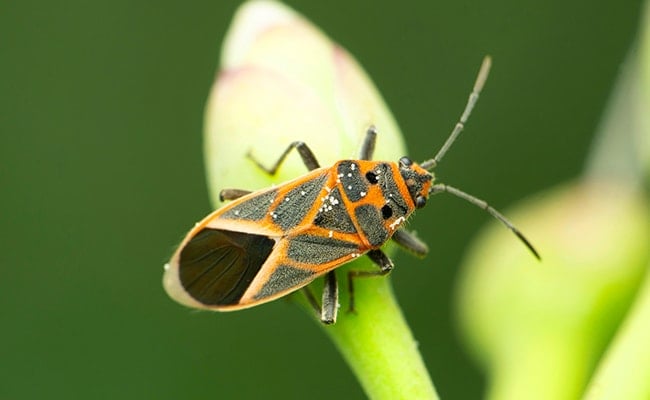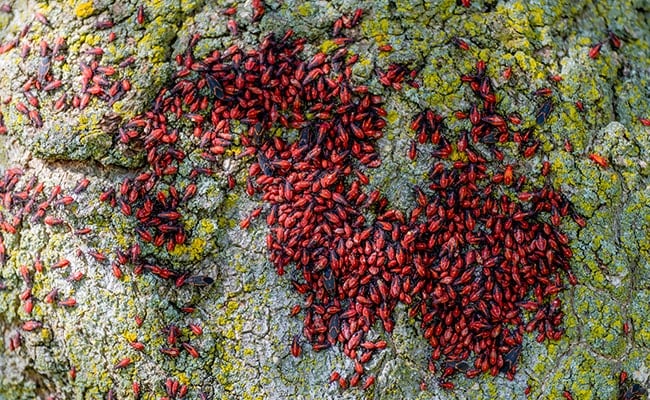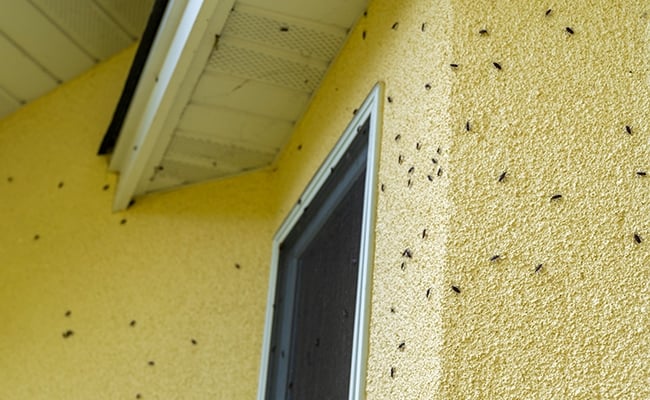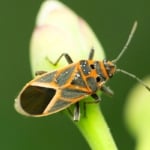Box Elder Bugs — Everything You Need To Know

Box elder bugs may be small, but they can become a significant nuisance to gardeners and homeowners alike. These sap-sucking insects, which are particularly attracted to box elder trees, may gather in large numbers, cause damage to plants, and invade the interiors of homes. Here is everything you need to know, including how to manage bug populations to minimize their negative effects on your property.
Understanding Box Elder Bugs
Box elder bugs are black insects with red or orange markings on their bodies. They’re typically about half an inch in length. As their name suggests, these bugs are primarily attracted to box elder trees. However, they can also infest other types of maple and ash trees. During dry summers they may infest fruit-bearing trees, consuming fruits such as almonds, cherries, plums, pears, or apples and leaving cosmetic damage to soft fruits like grapes or peaches.

These insects feed on the foliage, seeds, and new growth of host plants by piercing the plant tissue with their needle-like mouthparts. High populations may cause leaf discoloration or even premature leaf drop in affected trees.
Why Box Elder Bugs Invade Homes
As the weather cools in the fall, box elder bugs look for warm and sheltered locations to overwinter. This search for warmth can lead them inside our homes, where they may congregate around windows and doors for the duration of the colder months. Other attractive areas include basements, garages, and sheds.

Although they do not physically damage the outside of your home or pose a threat to human health, these unwelcome guests can certainly become a nuisance indoors, for instance leaving red stains (excrements) on clothes or linens.
How To Prevent Infestations
The best way to minimize the presence of these bugs around your home is by controlling their populations outdoors. Here are some practical steps you can follow:
- Seal any potential entry points: Make sure to repair or replace damaged window screens, weather stripping on doors, or cracks and gaps in your home’s exterior that can serve as access points for bug entry.
- Prune and maintain nearby trees and shrubs: Regular maintenance of these plants will help minimize the potential habitat for box elder bugs and make your yard less inviting.
- Apply insecticidal soaps or chemical controls: If bug populations are high, consider applying insecticidal soap or other targeted pesticides during the autumn to kill the insects before they move inside, following the label directions carefully.
- Sprinkle borax or diatomaceous earth: If you’ve had issues before, sprinkling borax or diatomaceous earth across doorways or window sills at the beginning of winter can discourage the bugs from entering again.
- Remove any box elder trees from your yard: Since these trees serve as the primary host, removing them from your property will likely discourage infestations. Here is how to identify them.
Dealing With Box Elder Bugs Indoors
If box elder bugs have already made their way inside your home, there are a couple of reasons why you don’t want to kill them immediately.
- Using insecticides or other methods to kill box elder bugs inside your walls will leave behind decaying bug carcasses. These carcasses are an attractive food source for dermestid beetles, like larder or carpet beetles, and can cause another year-around infestation problem.
- Box elder bugs are members of the family Rhopalidaethe. This family also includes stink bugs, with whom box elders share some smelly similarities: a box elder bug will release a nasty odor when disturbed or killed.
However, you can follow these simple tips to help manage the bugs until they move outside again in spring:
- Vacuum or sweep them up: When you spot these bugs indoors, using a vacuum cleaner or broom is often the easiest way to remove them.
- Shop-vac the colony: if you have a profusion of accessible bugs—often around door, windows, or cracks in walls—then another option is to use a Shop-Vac with a quarter to half inch of soapy water in the base of the tank. The bugs will suffocate in the water, allowing for easy disposal.
- Prevent future entrances: Work on sealing any potential entry points into your home as mentioned earlier to minimize the chances of another infestation.
A Final Thought
While box elder bugs may be an unwelcome presence in our homes and gardens, they can be effectively managed through proper prevention measures and prompt action when an infestation occurs.
By understanding these pests and implementing the strategies outlined above, you can help keep box elder bug populations under control and maintain a more enjoyable living space both indoors and outdoors.
Join The Discussion
What is your experience with these bugs?
Is there a box elder tree on your property?
Do you have any suggestions not listed above?
Share with your community in the comments below!

Elora Holt
Elora Holt is a writer and researcher based in Washington state. Her favorite topics revolve around digging up peculiar historical information—from uses of pig bladders to why glass went clear in the 1930s. Elora also writes for RevisitingHistory.com and Latino Alternative Television (LATV).




Do you live near a railroad? Is your farm producing a monocrop? How would you rate your soil quality? If you resonate with any of these factors, these bugs may be your friend.
Do they infest oranges. Some insect is boring 1 hole into all our oranges. They fall off the tree and are inedible. We have a Japanese maple across the driveway from the orange and for 3 months this summer these bugs were all over our driveway. Crawl, don’t fly.
Another note: birds will not eat them
I spray them with Dawn dish soap mixed with water in a garden sprayer. They die immediately. Cuts down their numbers.
Boxelder bugs (Boisea trivitatta) can be beneficial to the environment in a few ways, including:
Food source
Boxelder bugs are a food source for many predators, such as birds, spiders, and other insects.
Decomposition
As they feed on seeds, fruits, and other plant materials, boxelder bugs break down organic matter, which helps recycle nutrients in ecosystems. I think you need to be more honest with people and quit making the box elder bug look like a bad thing when they are a huge part of our ecosystem
Birds will not eat them.
They are a major pain and getting worse here in Oregon. You just cant stop them. But you CAN kill them with a sprayer and a few drops of Dawn. Its a never ending battle here.
They are a pain here in South Dakota, too. I spray them regularly with Dawn dish soap and water in a garden sprayer. They collect on plants with so many at once that the plant dies. They leave spots wherever they go and red stain if they are squashed. Some said the birds eat them. I’d like to know which birds because I’ve never seen that ever.
Great tip! Thank you for sharing – sorry you are having to deal with these plant killers. Sparrows and mockingbirds enjoy snacking on boxelder bugs, so do chickens, ducks and guinea fowl.